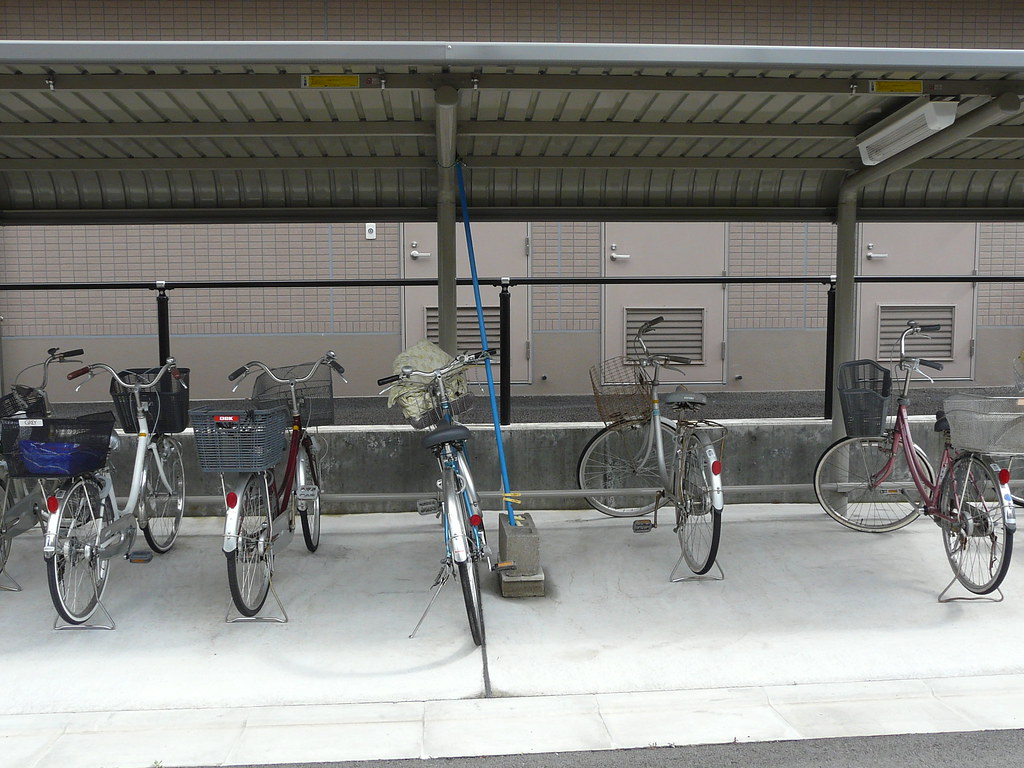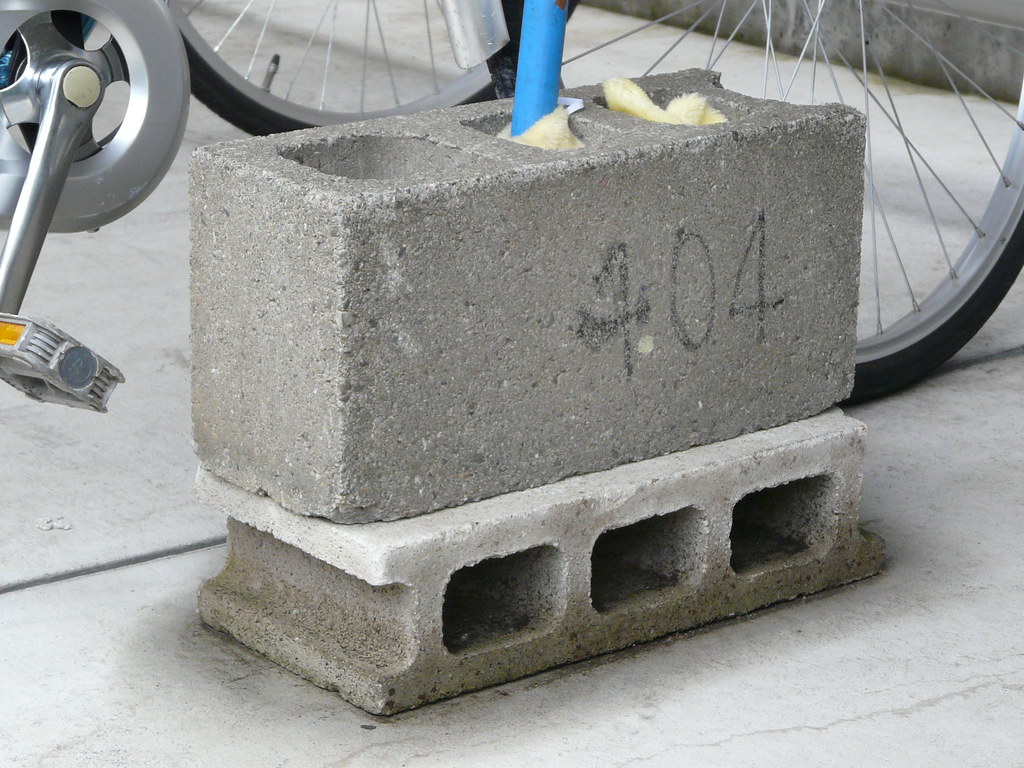Particularly intricate stabilisation system for parked bicycle. Prevents the bicycle blowing over in the wind, or being toppled by other errant parkers. It also provides a central stable element to prevent the whole row of cycles from falling in a strong wind.
A laundry pole is fixed to the parking structure with bungee cords at the top end. The bottom is stablised with breeze blocks and blanket scraps. The bicycle is attached to the makeshift structure with another bungee cord. The number written on the breeze block denotes the owner’s apartment number. I’m not sure of the function of the pegs and gloves.







Materials: Breeze Blocks, Bungee Cords, Blanket Scraps, Gloves, Pegs
Location: Setagaya, Tokyo.
This example is a note for a pamphlet on “Hand Made Aspects of Mass Produced Housing”. Subscribe to my somewhat-frequent letter HERE if you want to keep in touch easily.
Cut-off tyres guard against parking mishaps.




Materials: Tyres
Location: Nagoya
As noted in Deadspace Parking as BMX Training Course these income-generating asphalt plots become obstacle courses for budding and/or PRO suburban Tokyo BMXers from 12:30am onwards. Tonight as I return in the Dark Hourz I find the same man in a different coin parking space. I wonder whether he moves around to avoid detection or whether these spaces offer a valuable diversity of terrain that I have not before detected….. I need to look at those wheel clamps, judder bars and smooth asphalts more carefully.
Extra security by chaining bicycle to parking structure. Uncommon.

Location: Setagaya, Tokyo.
This example is a note for a pamphlet on “Hand Made Aspects of Mass Produced Housing”. Subscribe to my somewhat-frequent letter HERE if you want to keep in touch easily.
Perhaps these residents park their bikes further into the parking structure than planned (notice the front wheels over the back pole) to (1) keep their seats dry and/or (2) allow more room for thoroughfare.

Location: Setagaya, Tokyo.
This example is a note for a pamphlet on “Hand Made Aspects of Mass Produced Housing”. Subscribe to my somewhat-frequent letter HERE if you want to keep in touch easily.
Wet wipes on the handles of a child’s bicycle – for clean hands or clean handlebars?

Materials: Wet Wipes
Location: Setagaya, Tokyo.
This example is a note for a pamphlet on “Hand Made Aspects of Mass Produced Housing”. Subscribe to my somewhat-frequent letter HERE if you want to keep in touch easily.
Parking space for children’s bicycles. Bicycles locked together shows they are owned by a single family.

Location: Setagaya, Tokyo.
This example is a note for a pamphlet on “Hand Made Aspects of Mass Produced Housing”. Subscribe to my somewhat-frequent letter HERE if you want to keep in touch easily.
End piece added to bicycle parking port after complaints from residents about wind blowing over bicycles.

Location: Setagaya, Tokyo.
This example is a note for a pamphlet on “Hand Made Aspects of Mass Produced Housing”. Subscribe to my somewhat-frequent letter HERE if you want to keep in touch easily.
Problematic barrier post made more visible by affixing an old traffic cone with wire.



Materials: Wire, Traffic Cone
Location: Nagoya
Foam and duct tape create a safe + scratch free parking spot in a tight location.
(Note also how in the left-hand space storage trumps cars)





Materials: Duct Tape, Foam
Location: Nagoya
Beer crates placed in front of stop entrance create no-parking zones on days off.

Location: Nagoya
Materials: Beer Crates
Keeping a section of the curb car free (or permanently reserving a parking spot for the local ‘boss’) is carried out with the use of concrete junk, traffic cones and barriers.


Material: Concrete, Traffic Cone, Traffic Barrier
Location: Nagoya
A bit of greenification helps keep this inner-city commerce spot free of parked bicycles.
Nice contrast with residential areas, where pots trump cars – see [HERE] and [HERE]



Materials: Potplants
Location: Central Nagoya
Long roadside planter constructed of loosely packed bricks also functions as parking deterrent on residential street.




Materials: Bricks
Location: Akishima-shi, Tokyo
Traffic signage put to a different traffic related use with the help of marker and paper.



Materials: Paper, Marker
Location: Akishima, Tokyo
Small space + oversize auto = reflective parking tape on a dangerous corner.



Materials: Reflector Tape
Location: Akishima-shi, Tokyo
Pot plants along footpath used as bicycle parking.



Materials: Pot Plants
Location: Akabanebashi, Tokyo









































































